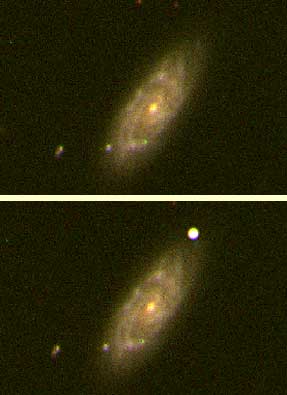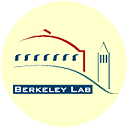|
|
 |
BERKELEY, CA — In the spring of 2001, NASA's
Hubble Space Telescope will catch nearby supernovae in the act of
exploding at prescheduled times, the targets to be supplied "on
demand" for the first time. Spectra from these nearby supernovae will
be used to calibrate measurements of the accelerating expansion of the
universe.
 |

THESE IMAGES OF THE SAME PATCH OF SKY, TAKEN A FEW WEEKS APART
WITH THE MOST RECENT IMAGE AT BOTTOM, REVEAL A NEARBY TYPE IA
SUPERNOVA, SN1999BE, AT THE EDGE OF GALAXY CGCG 089-013 IN THE
CONSTELLATION CANCER. CAUGHT APPROXIMATELY ONE WEEK AFTER ITS
PEAK BRIGHTNESS, THE SUPERNOVA IS STILL VIRTUALLY AS BRIGHT AS ITS
ENTIRE HOST GALAXY.
|
Peter Nugent and Daniel Kasen, members of the Supernova Cosmology
Project headquartered at the Department of Energy's Lawrence Berkeley
National Laboratory, along with Edward Baron and David Branch of the
University of Oklahoma, will use the ultraviolet spectra of nearby Type Ia
supernovae (roughly, those less than a billion light-years away) to
determine what effects their evolutionary history may have on their use as
"standard candles" to make fundamental cosmological
measurements.
"Since all Type Ia supernovae have nearly the same brightness,
they have been used to compare the distance and redshift of the galaxies
in which they occur, and thus to measure the expansion rate of the
universe," says Nugent, an astrophysicist with the National Energy
Research Scientific Computing Center (NERSC) at Berkeley Lab. "The
conclusion that the universe is accelerating, reached in 1998 by the
Supernova Cosmology Project and our colleagues in the High-Z Supernova
Search Team, was based on comparing dozens of Type Ia supernovae spanning
a huge range of redshifts."
Type Ia supernovae are similar because their progenitor stars are white
dwarfs that accrete mass from their partners in a binary system, exploding
in a thermonuclear blast when the mass exceeds a specific limit, 1.4 times
the mass of our sun.
However, very distant supernovae -- those up to eight billion
light-years away -- exploded when the universe was only half its present
age, and their progenitor stars may have been poor in elements heavier
than hydrogen and helium. "Hydrogen and helium and a little bit of
lithium were made in the big bang, but heavier elements were made later in
stars and supernovae," says Nugent. Even in the earlier universe the
age of individual galaxies varied greatly, but since nearby supernovae
occur in an older universe, some of their progenitors may be richer in
metals.
The ratio of heavier elements to hydrogen and helium is known as
metallicity. Nugent and his colleagues used the IBM SP supercomputer at
NERSC to develop a theory of how metallicity should affect the spectra and
light curves (patterns of rising and falling brightness) of supernovae,
investigating whether differences between nearby and distant supernovae
might lead to systematic errors in comparing their redshifts and
magnitudes.
"We studied what the spectrum should look like if a supernova's
progenitor star is much poorer or much richer than our sun in iron,
cobalt, and nickel. We concluded that distinct differences would be
evident in the ultraviolet part of the spectrum, although there should be
virtually no difference in the optical spectrum," says Nugent, adding
that "since the Supernova Cosmology Project and the High-Z Supernova
Search Team based their results on the optical part of the spectrum, this
is good news for the accelerating universe."
Meanwhile, Berkeley Lab's Greg Aldering and other members of the
Supernova Cosmology Project had used the telescope of the Near Earth
Asteroid Tracking System (NEAT) on Mount Haleakala on Maui, operated by
NASA's Jet Propulsion Laboratory (JPL), to develop a method for finding
nearby supernovae "on demand," similar to the method the
Supernova Cosmology Project had earlier devised to find distant
supernovae.
They scanned wide areas of the sky, then covered the same areas again
some weeks later to see if any supernovae had appeared. The wide search
was necessary because Type Ia supernovae occur only once or twice a
century in a typical galaxy. Before the Supernova Cosmology Project's
collaboration with JPL, most nearby supernovae were found by amateur
astronomers or by small dedicated telescopes looking at one galaxy at a
time. Using NEAT, just over one night of observing time was needed to find
five nearby supernovae, three of which were Type Ia's.
"Now we know how to find nearby supernovae on schedule, and we
know what we should see when we look at them," Nugent says. Based on
these expectations, NASA committed observing time on the Hubble Space
Telescope this spring. "Unlike much of supernova astrophysics, where
theorists struggle to explain unexpected observations, this is a case
where theory will drive observation."
During the spring search NEAT will scan 500 square degrees of sky -- an
area equivalent to 2,000 full moons -- every night for two weeks, then
make repeat images of the same areas. As the later images are made,
NERSC's computing facilities will subtract the two sets from one another
in real time, processing some 50 gigabytes of data each night. The bright
spots left once the images have canceled one another are supernova
candidates.
A host of observatories will be involved in selecting the final
observational choices, including the Las Campanas Observatory in Chile
operated by the Carnegie Institution of Washington, the Kitt Peak National
Observatory and the Cerro-Tololo Inter-American Observatory operated by
the National Science Foundation's National Optical Astronomy
Observatories, and the Lick Observatory operated by the University of
California Observatories.
Beginning in April, 2001, the Hubble Space Telescope will observe
chosen supernovae every week for six weeks, yielding light curves and
ultraviolet spectra that will allow a precise correlation of metallicity
and distance. "Presently there is a seven to 10 percent uncertainty
in the distance of Type Ia supernovae," says Nugent. "By
eliminating systematic uncertainties, we hope to be able to improve them
as distance indicators."
The observational team will include Nugent, Aldering, and Saul
Perlmutter of Berkeley Lab, Mark Phillips, associate director of Las
Campanas Observatory, and Adam Riess of the Space Telescope Science
Institute.
In hopes of collecting many thousands more supernovae in future, the
Supernova Cosmology Project at Berkeley Lab has joined with other groups
to propose a satellite, the SuperNova/Acceleration Probe (SNAP).
"These Hubble observations could affect how SNAP collects data and
what conclusions we could draw from it," says Nugent. Spectral
studies requiring dedicated Hubble time would be routine with every one of
SNAP's supernova observations.
Theoretical studies of how evolution may affect cosmological
measurements using both Type Ia and Type II supernovae were reported by
Nugent and his colleagues at the annual meeting of the American
Astronomical Society in San Diego, CA, this January. Among the federal
agencies supporting the theoretical and observational studies of nearby
supernova metallicity have been the Department of Energy's Office of
Science, NASA, and the National Science Foundation.
The Berkeley Lab is a U.S. Department of Energy national laboratory
located in Berkeley, California. It conducts unclassified scientific
research and is managed by the University of California.
Additional information:
|

